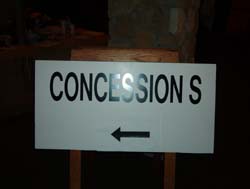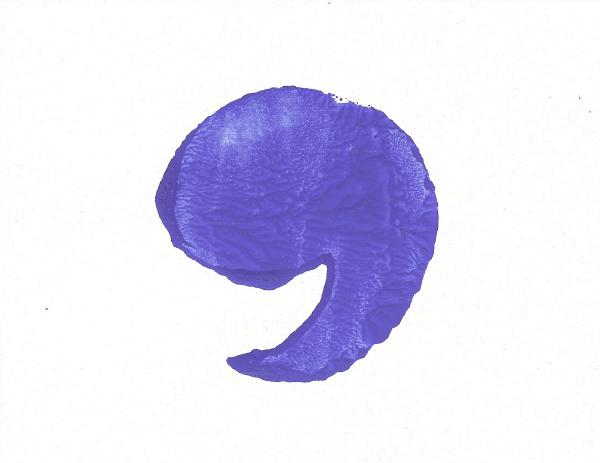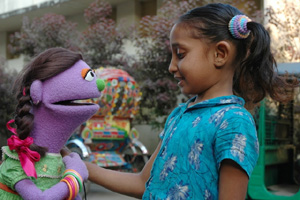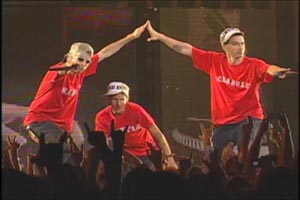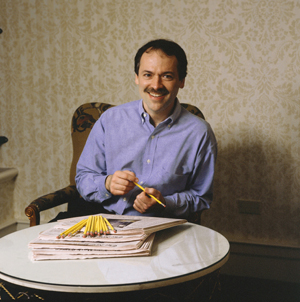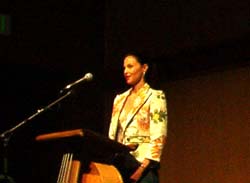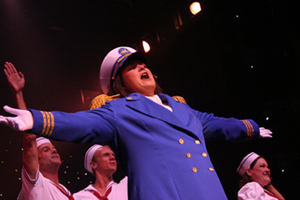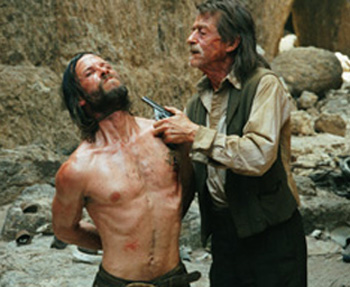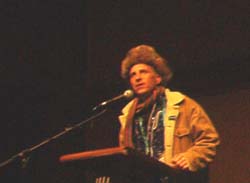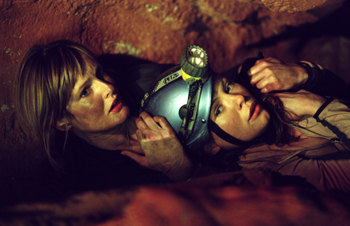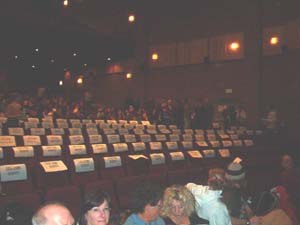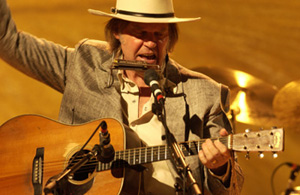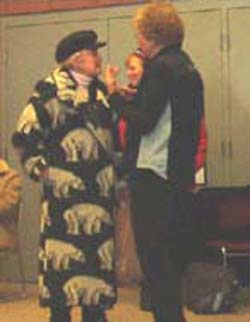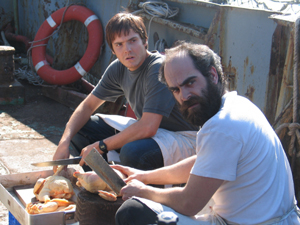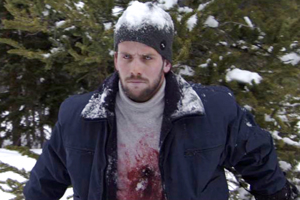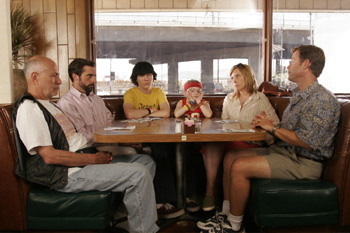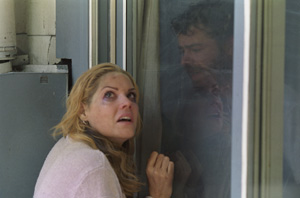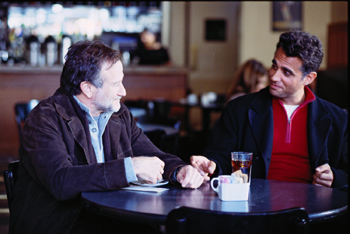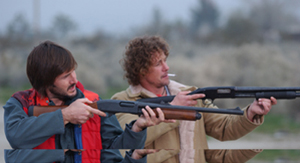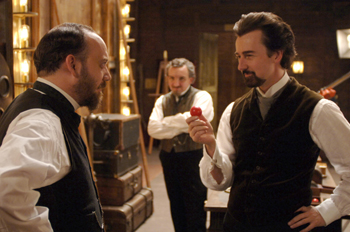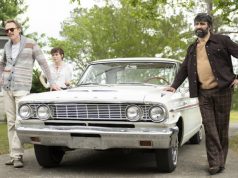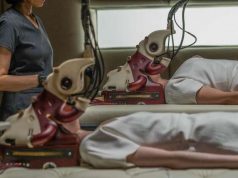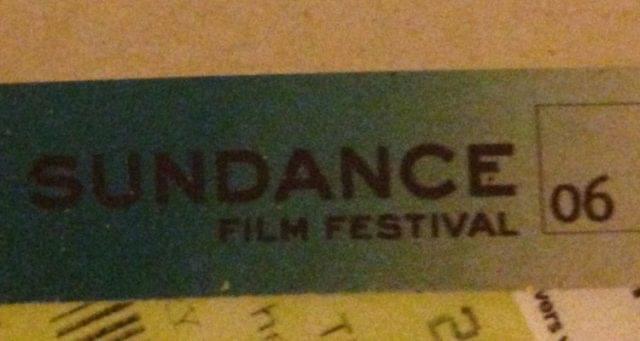
Day 1 (Thursday, Jan. 19):
For some people, Sundance begins on a Thursday. Those people are called suckas. Day 1’s activities are limited to one (1) screening of a specially selected “opening night” movie, in a big gala whoop-de-doo usually hosted by leathery Sundance founder Robert Redford. It’s an ordeal to get into the event, and the movie is seldom one of the fest’s better offerings. So why bother?
I couldn’t have attended the opening-night festivities this year even if I’d wanted to, because my presence was required for a meeting of Salt Lake City Weekly’s festival coverage team. For the first time, City Weekly is printing three special editions during the festival, and they’ve asked me to provide some content, mostly in the form of these daily diary things. (You may know that I always come to Sundance and do these diaries anyway, for free. So whatever City Weekly is paying me, it’s a waste of money.)
City Weekly has put us up in a charming condo near The Canyons ski resort. It has four beds, which is only two less than the number of people staying there. “Roughing it” is always part of the Sundance experience, though. Many Hollywood bigwigs spend the entire week in Park City without once snorting cocaine off a hooker’s chest. (OK, that’s not true.)
The necessary introductions were made, and the full-time staffers accepted me and the other freelancers with far more graciousness than freelancers usually get, considering most of us want to steal their jobs. Once we were settled, everyone retired to bed (or couch) before midnight. We had a big day ahead of us. It was literally the earliest I have gone to bed since I had the flu.
Day 2 (Friday, Jan. 20):
Contrary to my usual modus operandi, I not only INTENDED to get up early this morning and catch a 9 a.m. screening, but I actually DID it. Park City was beginning to buzz with activity as I shuttled to the Yarrow Hotel for the first press screening of the day. People’s eyes were bright, and their tails, as far as I could discern, were bushy. It was the first real day of Sundance! The air was cold, but the skies were blue and clear. Everywhere you turned, you could smell independent film. (It smells like Steve Buscemi.)
The driver on this shuttle bus had a serious case of the perkies. She chattered nonstop throughout the 10 minutes I was aboard her vehicle, giving a running commentary on traffic conditions, on the difficulty of a particular turn, on the proximity of the festival venues to each other. She did this regardless of whether anyone was sitting close enough to be listening to her.
The Yarrow Hotel is home to two venues, both of which are used almost exclusively for press screenings. In the lobby this morning was a sign that said “CONCESSION’S,” pointing to a maintenance closet that magically becomes a snack bar when Sundance is in town. Yes, “CONCESSION’S.” As a writer, I am more offended by the misuse of apostrophes than I am by reports of genocide in faraway lands. Unable to bear seeing this sign every day for the next week, I peeled off the errant punctuation mark and kept it as a trophy.
The 9 a.m. film was “Lucky Number Slevin,” a stylish gangster flick about a man mistaken by two different bosses for the guy who owes them money. It’s put together well, and it has a cast that includes Bruce Willis, Morgan Freeman and Sir Ben Kingsley — the “Sir” is right there in the onscreen credits — but it doesn’t add up to much. I think it’s too impressed with its own cleverness. But I guess we’ve all been there.
After “Lucky Number Slevin,” I had just enough time to grab a slice of pizza from the concession’s stand before the next film. I asked the woman for a receipt, and she acted like it was the most bizarre suggestion anyone had ever made to her, like I had asked her to give me the receipt in the form of an interpretive dance. Now, I agree it’s silly to get a receipt for a slice of pizza. But when it costs $2.50, and when you’re being reimbursed for your expenses, you have to admit there’s a certain logic to it.
Anyway, the next film, in the same venue as the last one, was “Kinky Boots.” It’s about a guy whose father dies, leaving him to try to save the family’s factory — so it’s a total rip-off of “Tommy Boy,” only with shoes instead of auto parts. They wind up specializing in thigh-high boots designed for drag queens and transvestites, which is fairly unusual, I’ll grant you. But the movie is still one cliché after another, culminating in (of course) a fashion show/performance that aaaaalmost doesn’t happen, and then the star performer arrives at the last minute and saves the day!!!!!!!! I liked it better the first time I saw it, when it was called “Every Movie I’ve Ever Seen.”
Sitting behind me for this film was Roger “Three Stars” Ebert, the dean of modern film criticism and bestower of more thumbs up than a Palm Beach proctologist. (Thank you! I’ll be here all week.) I always enjoy listening to Ebert, a world-class raconteur, regale his seatmates with stories before screenings. Unfortunately, when the film began and everyone was quiet, Ebert said something out loud in regards to one of the characters onscreen: “She was in ‘Lovely & Amazing’!” And I thought: Am I going to have to shush Roger Ebert?! Because that would be awesome. I would regale listeners with THAT story for years to come. Alas, he was well-behaved for the rest of the film.
After “Kinky Boots,” I hopped over to the Holiday Village Cinemas, where the third press-screening venue is. In the doorway to the facility was a melee, an absolute brouhaha, a veritable donnybrook. You see, members of the press are supposed to sign in at these press screenings so that the films’ publicists know who saw their film, so they can track you down later and try to extract positive feedback from you. But instead of having a festival volunteer jot down your name and affiliation as you enter the theater single-file (as they do at the Yarrow), they were making everyone sign the list themselves, which led to this massive group of journalists clamoring around the table, scribbling their signatures illegibly. Some people were just skipping the sign-in process and walking in. Apparently the volunteers had held a meeting and had chosen the most inefficient means for sign-in that they could conceive.
Once we were signed in, we still couldn’t enter the theater because a movie was still playing there. Someone had scheduled a 164-minute film for a slot that only had 150 minutes in it, and now those additional 14 minutes were spilling over into our film’s slot. So we loitered in the hall, grumbling and swearing like an angry mob. Then, finally, we were allowed to watch the documentary about “Sesame Street.”
“The World According to Sesame Street” sure sounds nice, but it sure is too long and kind of boring. It should actually be called “Sesame Street According to the World,” because it’s about how “Sesame Street” is altered when other nations produce their local versions of it, like having a drug-lord Muppet in the Colombian edition, or whatever.
Now, I’m not usually in favor of teaching foreign children to read, but the “Sesame Street” people have their hearts in the right place. I just wish the film had focused less on the boring producers who conceive the shows and more on the local performers who spend their days with their arms up the plush backsides of monsters (which reminds me of another Palm Beach joke, but never mind).
There were some irritations during this screening unrelated to the film itself. I was sitting in the back row of the theater, and next to me were three a-holes. They were men in their early 30s who are in the film industry somehow and who were so important that they couldn’t be expected to just sit and watch the movie. No, these a-holes were so important they had to fiddle with their BlackBerrys during the film, and talk to each other during the film, and just generally behave like the a-holes they were.
The light that emanates from a BlackBerry or other personal electronic device is very distracting in a darkened theater, as I’m sure you know. In fact, I’m sure everyone knows that — everyone except for a-holes, of course. They’re too important to know things like that. They have interns and assistants to know that sort of thing for them.
One of the a-holes left 30 minutes into the film, but only after much consulting with his BlackBerry and important chatting with his companions. This left the two remaining a-holes to ignore the movie and behave boorishly.
When the film ended, the a-hole immediately to my left stood up and, in the process, dropped his BlackBerry. It clattered on the floor and fell into the recess beneath the seats in front of us, whence nothing can return without a struggle. So be aware that the laws of karma are strictly enforced in Park City.
I had some time before my next film, so I went to festival headquarters for the first time this year. I recognized many staff members from previous years, and even some publicists, with whom I generally try not to make eye contact. I bought a deli sandwich for $4.50 — a ridiculous price given its teeny size, but one doesn’t worry about such trivial matters when one’s expenses are being reimbursed.
Then it was up to Main Street for me, to get a taste of festival flavor amid the throngs of gawkers, onlookers and posers. I saw a man whose festival badge indicated his name was Ham Tram, and another whose first name was allegedly “Stash,” though I am skeptical of that one.
I stopped in at the Sundance House, which is a place for passholders to lounge, relax and revitalize. While I was clacking away on my laptop (which technically is neither lounging, relaxing nor revitalizing), I was accosted by my old friend Jamal, who has somehow risen to a level of some responsibility on the Sundance Film Festival staff and was helping to oversee the goings-on at the Sundance House. He indicated that boozemaker Stella Artois was hosting a party where I could find free food and drink; alas, Jamal’s intel proved faulty as ever. There was no food, and the only beverage was, um, Stella Artois beer. So it was Burger King for me!
My last film of the day was back at the Holiday Village, where they’d seen the error of their ways and had a much smoother sign-in process in place. The movie was “Wide Awake,” a rather fascinating documentary about a guy who can’t sleep for crap. I mean he’s actually a bad sleeper. You’d think it would come naturally, but apparently not. Anyway, it’s dangerous to show a movie about sleep deprivation to a theater full of people who are sleep-deprived, but this guy pulled it off, so my figurative hat is off to him. And speaking of sleep, it was now time to return to the condo and get me some o’ that.
Day 3 (Saturday, Jan. 21):
For some reason, I had it in my head that I would get up in time to catch an 8:30 a.m. screening today. Part of me knew this was sheer folly, but it wasn’t until my alarm went off at 7:30 that the rest of me was convinced too. If it had been a film I was particularly eager to see, I’d have managed it, but it was only a press screening of “Friends with Money,” which was the opening night film and which, according to custom, is probably only so-so.
It was a cold, snowy day, not good festival weather at all. But though the weather outside was frightful, the films were so delightful, like a shot of hot chocolate delivered directly into a moviegoer’s veins.
First up, at 11 a.m., was “Eve & the Fire Horse.” This is the kind of movie that reinvigorates a festival attendee, especially after the mediocrity of yesterday. I saw it not because the description looked interesting (it didn’t), but because the other films playing at the same time were distinctly UN-appealing. And what a swell surprise it was! Set in Vancouver in the 1970s, it’s about three generations of a Chinese family, the older ones born in China, the younger ones in Canada, all of them mixing their Eastern superstitions and traditions with Western ones as they search for happiness. The story is told with humor and grace, with enough characters to provide fodder for several inter-related subplots and tangents. So hooray for Eve and her fire horse!
While waiting in the Yarrow Hotel lobby afterward, I overheard two industry types discussing the festival. One of them said Sundance was like “Groundhog Day,” in that you wake up each day and do more or less what you did the day before. The other one said, “I love ‘Groundhog Day.’ Harold is a good friend of mine.” She meant Harold Ramis, of course, the film’s director. This led to a discussion of Harold’s other films, including 1996’s “Multiplicity,” which one of them felt was an overlooked gem but which neither of them could remember the name of. (I was going to interject and tell them, but I didn’t want them to know I was eavesdropping. Sometimes you have to make sacrifices like that.)
Thereafter, I met up with my pals from HollywoodB****slap.com — Erik “The Movieman” Childress, Scott “The Angry Jew” Weinberg, and Collin “No Nickname” Souter — for a press screening of a Beastie Boys concert film. The Boys handed out video cameras to 50 audience members, and those frat boys and stoners provide most of the movie’s footage — hence the film’s title: “Awesome; I F*****’ Shot That!” I braced myself. When there’s a curse word right there in the title, you know the movie itself is bound to be effing full of it.
But the Beastie Boys put on a pretty lively show. Their beats are funky, their rhymes are fresh, their style is fly. What more do you want? Intelligible lyrics? Professional cinematography? That’s whack, yo.
It was snowing persistently after the film ended, which made it all the more pleasant when Scott and Erik spent the next 1,000,000,000,000 minutes arguing over whether the movie sucked or not. (Erik: sucked. Scott: did not suck.)
I left Siskel and Jewbert and wedged myself into an overcrowded shuttle bus bound for Main Street. I had my butt in some woman’s face, and my face was two inches from another man’s neck. So it was a typical Saturday, I guess. KA-ZING!
It turned out the narrow avenues of the Main Street district were as crowded as the bus was. If you had poured out a bucket of water inside the bus and then opened the doors, the water wouldn’t have spilled out, because the pressure outside was greater than the pressure inside. Since I am not water, however, I went against the path of least resistance, exited the bus, and inched my way down Main Street. This concludes the physics portion of today’s lecture.
There were no celebrities about, but there were hundreds of people milling around looking for them. The thing about Main Street is that the sidewalks are narrow, so walking arm-in-arm with your sweetheart, while cute, is also selfish and stupid, because it means no one can get past you. Let go of her for two minutes, for crying out loud! She’s not going to escape!
At the Sundance House, I saw famed marijuana addict and former actor Dennis Hopper. He was flanked by handlers and assistants, and they were escorting him somewhere important. This marks the second time in six months that I have been next to Dennis Hopper, the other time being at the CineVegas Film Festival last June. Who besides his Narcotics Anonymous sponsor can say that?
I eventually made my way back to the Yarrow, where the 5:30 p.m. screening of “Wordplay” was being delayed. It seems a panel discussion on film technology had run long, allegedly because it had started 20 minutes late, allegedly because they couldn’t find a phone book for Robert Redford to stand on so he could see over the podium. (Because he’s short, you see. Ahem. Is this thing on?)
Anyway, we eventually got in and watched “Wordplay,” a funny and upbeat documentary about the New York Times crossword puzzle’s legendary status among casual solvers and professional puzzlers alike. Like “Spellbound” (spelling bees) and “Word Wars” (Scrabble) before it, “Wordplay” culminates in a tournament, where victory and heartbreak for the crossword solvers are doled out in equal measure. What’s a 20-letter word for “nerds”? Thepeopleinthismovie.
Sitting next to me in this screening was Edge Publications’ Jason Salzenstein, who was wearing a designer yarmulke with a little Izod alligator on it. I note on Edge’s Web site that Jason is the style and travel editor, so if he’s wearing a designer yarmulke, it’s apparently OK, at least from a fashion standpoint.
After a short break, many of the same people were back in the screening room again, this time for “Somebodies.” Every year there is one film in the Dramatic Competition category that is so bad, you wonder if the festival programmers even watched it. “Somebodies” is that film for 2006. (At least, I hope it’s that film. I shudder to think there’s one that’s worse.) It actually starts out well, with a lot of laughs as we follow a slacker African-American college student through his days of drunkenness and womanizing. But 20 minutes in, the film loses steam and becomes an endless series of pointless, unfunny scenes and subplots. Rarely have I seen a film turn from good to evil so rapidly.
As a side note, I caught these two names in the credits: IronE Singleton and Nard Holston. IronE? Nard? Come on, people. If you’re going to be in a movie, you need to have a name. (I’m looking at you, too, The Rock.)
And that was it for the day: four movies today, eight total, about 40 to go. I caught a shuttle back to my car and, as I opened the door, broke the handle off in my hand. Apparently I don’t know my own strength! I felt like Ben Grimm in “Fantastic Four,” only without the shame of knowing I was in a terrible movie that had conned millions of people out of their hard-earned money. Of course, it’s possible the car’s age (10 years) and Park City’s temperature (well below freezing) had something to do with it, but I’m not going to question my superpowers.
Day 4 (Sunday, Jan. 22):
The skies were sunny and clear today, but the temperature was only in the upper teens, making it one of the coldest festival days I’ve experienced. It was so cold that photographers’ lips were actually freezing to Gwyneth Paltrow’s butt.
Prior to today, all the films I’d seen had been at press screenings, which are convenient and efficient but also rather sterile. If you want to truly experience Sundance, you need to attend public screenings, where industry types and Hollywood shmoozers and regular movie-lovers gather together. So I spent several hours today at the Eccles Theatre, where the high-profile movies screen and where there’s always something interesting happening.
Before the first film, though, I used the restroom at the Eccles and once again demonstrated my newfound super-strength. (See yesterday’s report.) When I pulled toilet paper from the industrial-size dispenser, the entire dispenser broke off the wall and clattered to the floor. As hack writers say, “As Dave Barry would say, ‘I am not making this up.'”
My first film, at the dreadful hour of 9:15 a.m., was “Steel City,” a sturdy, well-made drama (sturdier and better-made than that toilet paper dispenser) by first-time filmmaker Brian Jun. It deals with a young man whose father is in jail for vehicular manslaughter, whose older brother is a low-life adulterer, and whose job washing dishes at a restaurant is in jeopardy. So, you know, it’s really fun.
To gain access to public screenings at the larger venues (including the Eccles), members of the press need only show up an hour before show time and get a ticket. As luck would have it, they had just started handing out tickets for the next film when “Steel City” ended. So I nabbed one and dashed over to headquarters for a few minutes before returning to the Eccles for the noon film.
The noon film was “Come Early Morning,” the writing and directorial debut from actress Joey Lauren Adams, who you may remember from such films as “Bride of Chucky” and “The Haunted Mansion,” until you realize that that’s Jennifer Tilly you’re thinking of. Then you give up on Joey Lauren Adams and consult the Internet Movie Database to find out she was in a bunch of Kevin Smith movies and Adam Sandler’s “Big Daddy,” which you totally saw but have little memory of.
Anyway, while “Steel City,” lacking any big-name actors (and showing at 9:15 a.m.), had played to quite a few empty seats, the Ashley Judd-oriented “Come Early Morning” was packed to the rafters. I sighed. Why would you go to Sundance just to watch an Ashley Judd movie? That’s like going to Monte Carlo and eating at McDonald’s.
Ashley Judd is OK in the film, which is another drama about another screwed-up character trying to make another change in her life. My City Weekly pal Scott Renshaw said something about “Sherrybaby” (another festival film) that applies to “Come Early Morning,” too: When it comes to these 90-minute dramas, you always know that at the 65-minute mark, the main character is going to backslide, relapse or fall off the wagon. And sure enough, Judd’s character, a reformed alcoholic skank, returns to her life of alcoholic skankery at an hour and five minutes into the movie, only to (spoiler!) triumph once and for all by the end.
Joey Lauren Adams was on hand for a Q-and-A after the screening, and she brought several cast and crew members onstage with her, including Judd. When someone asked her how she crafted her performance as the slutty barfly, Judd responded with an answer that included the words “vibrations,” “energy” and “organic.” So maybe she belongs at Sundance after all.
I should mention that before the film started, someone in the audience had a laser pointer that he kept shining at the screen. I thought: A laser pointer? Where does this guy live? 1998?
I should also mention that while the press screenings, attended by 300 people at the most, routinely start as much as 10 minutes late, both of these Eccles screenings — with crowds of 1,300 to wrangle — started only five minutes late. I’m just sayin’.
Immediately after the Q-and-A, I picked up a ticket for the NEXT Eccles film, due to start at 3 p.m. With another hour to kill, I hung out in the Eccles lobby, where two women asked a man I did not recognize if they could get a picture with him. They were excited, and I heard one of them use the word “celebrity.” But despite watching a lot of movies and a lot of TV, I had no idea who this man was. He didn’t look the least bit familiar. Yet these women, who surely cannot be more pop-culturally savvy than myself, knew him. What’s up with that? Am I slipping?
(It is times like that when I wish my cell phone took pictures, so I could run the guy’s face through one of those magic databases like they have on “24” and identify him. My digital camera would have been too obvious and tacky, I think.)
The 3 p.m. film was “Everyone Stares: The Police Inside Out,” a documentary about 1970s and ’80s rock band The Police, culled from footage shot during those years by drummer Stewart Copeland. Predictably, this screening was packed, too; the ones about rock bands always are, even when the only band member scheduled to appear in person is the drummer.
After claiming a seat, I left the theater to use the bathroom, and on the way I noticed that three entire rows had been roped off for Copeland, his guests, and people connected to the film. I pointed out to one of the volunteers that it seemed like a larger number of seats than usual — typical, I guessed, of movies about rock stars, even former rock stars, who cling to their glory days by continuing to travel with large entourages. But the volunteer said that in fact this was FEWER seats than are usually reserved for the filmmakers and their guests. And just like that, the situation went from amusing to sad.
The girls who sat next to me, trendily dressed Californians, hooted like banshees when Stewart Copeland came onstage to introduce his movie. They also ululated through the first few minutes of the film, until they realized, as did the rest of us, that it was kinda boring. Turns out Stewart Copeland’s home movies are as dull as everyone else’s. Who knew?
I could not stay for the Q-and-A, as I needed to get to the Yarrow in time to eat some dinner before my 5:30 press screening. I ate at The Corner Cafe, the Yarrow’s little restaurant. I used to eat there frequently during the festival but for some reason had not in recent years. Now I remember why: 10 dollars for a hamburger and inattentive service. Up yours, The Corner Cafe. That’s the last $10 you’ll get from me, to be reimbursed later by City Weekly!
The 5:30 screening was “All Aboard! Rosie’s Family Cruise,” a harrowing documentary about the time in 2004 that a couple thousand people were trapped on a boat with Rosie O’Donnell. Hundreds were devoured.
But I kid the bleating she-moose! The movie is an account of the seven-day cruise Rosie and her partner sponsored that was aimed specifically at gay couples and their children. There are gay cruises all the time, of course, as recounted in the Cuba Gooding horror film “Boat Trip,” but gay cruises designed for families (i.e., without rampant sex and booze) are rare.
This documentary suffered from the same problem as Stewart Copeland’s: Just because you have filmed an event doesn’t mean you have made a movie. Movies, even documentaries, have stories for an audience to follow. Showing random vignettes of people on a cruise ship is not a movie. That is surveillance footage.
My fifth (fifth!) movie of the day was “The Proposition,” written by creepy musician Nick Cave. If you love brutal violence and the buzzing of flies, I urge you to seek out “The Proposition,” which is set in Australia circa 1900 and features ample servings of both. It also has Guy Pearce and his 24-inch waist. I bet I could break that guy in half, even without my super-strength.
Day 5 (Monday, Jan. 23):
I began the day with being ripped off by a bagel salesman.
In the Eccles Theatre lobby, there is a makeshift franchise location for Park City Coffee Roasters, at which coffee, pastries and other goodies are sold during the film festival. I bought a bagel there yesterday morning for the posted price of $1.50.
Today, I bought the same kind of bagel from the same counter, though it was a different employee, an old man with a mustache. I handed him a $5 bill and he gave me back $2.50.
I said, “Isn’t it $1.50?”
“It’s $2.50 with cream cheese.”
“No, this one’s plain.”
“Oh, OK. Two dollars, then.”
“The sign says $1.50.”
“No, it’s $2.
“Then why does the sign say $1.50?”
“The sign is wrong.”
“I paid $1.50 yesterday.”
“Oh, no. No, it’s $2.” He said that as though he didn’t believe me that I had paid $1.50 yesterday, as if it were some preposterous lie I had made up.
“No, I really did pay $1.50 yesterday,” I said. “That shouldn’t surprise you, considering that’s the price on the sign.”
“No, it’s $2.”
In retrospect, I should have refused to buy the bagel for anything above the posted price of $1.50. But by this time, I was already handling the bagel with my sweaty mitts, and there were people in line behind me, and the man was so clearly uninterested in making his customers happy that I felt I had no choice but to pay $2 for the $1.50 bagel. Never again, though!
It’s kind of a hassle keeping track of all the establishments I won’t patronize because of their shoddy business practices.
The first movie of the day, again at 9:15 a.m. and again at the Eccles Theatre, was “Stay,” written and directed by Bobcat Goldthwait. About 10 years ago, there was a trend for performers to remove all references to wild cats from their names, perhaps due to the feline AIDS epidemic (which is the number one killer of domestic cats in America). So we had the de-cougarization of John Mellencamp, and Mr. Goldthwait started going by just Bob. He was introduced as Bob, and his festival pass said Bob, but the credits for his movie said Bobcat. So he’s still Bobcat as far as I’m concerned.
His movie is an attempt at randy sexual humor in which a woman has an embarrassing secret in her past that she believes will cause those she loves to shun her if they ever learn of it. (It involves a dog. That’s all I’m sayin’.) The movie is often raucously funny, but it’s really a one-joke affair. Imagine if “There’s Something About Mary” had been centered entirely around the hair-gel scene, rather than just including it as one component in a larger story.
Bobcat introduced the film very graciously and warmly, apparently genuinely humbled at being invited to the festival. “I once rappelled nude from the roof of the Oakland Coliseum during a Nirvana concert,” he said. “I’m more nervous today.”
Afterward, he told several amusing stories about the production, including finding his cinematographer on Craigslist, and breaking into an unoccupied home’s garage to film a scene. He’s a funny guy, that Bobcat.
Next I joined HollywoodB****slap.com pals Erik and Scott at the Yarrow for a press screening of “The Descent,” a horror film that premiered in England last year and is due out in the States in a few months. It bears an unfortunate (and coincidental) similarity to “The Cave” — unfortunate because it’s a thousand times better, but will probably be thought of as a copycat.
It’s about six hot women who go spelunking and encounter danger and/or death. It’s a terrifying movie, I kid you not. Just like “Super Size Me” made some people stop eating fast food, “The Descent” will surely make people stop exploring uncharted caves where there are monsters.
I had a few hours before my next screening — which is to say, there were press screenings right away, but nothing I was particularly interested in seeing. You have to pace yourself at Sundance; it’s a marathon, not a sprint. If you watch movies for 12 hours straight without a break, you’ll burn out in a few days, no matter how much you love movies. I have learned this from experience.
So I headed up to Main Street. With the weekend over, the crowds had thinned somewhat; people do have jobs to go to, I guess, even during the Sundance season. I stopped at the Sundance House for a while and as I was clacking away on my laptop, a pretty blond woman stopped next to me and said, “Hello.” I returned the greeting, skeptical as to her intentions, as it is not often that pretty blondes speak to me without provocation.
Sure enough, she wanted me for my Internet: She needed to find out the name of some contact of hers, and she wondered if I would be so kind as to go to the company’s Web site. I was glad to be of service. I retrieved the necessary info for her, and to thank me, she gave me a yo-yo emblazoned with her organization’s logo: Animal Content in Entertainment (www.ace-tvfilm.com), a group that apparently wants to see more TV shows and movies about animals. They’re not PETA or anything crazy like that; their Web site says, “We hope that as writers, producers, and directors you will be inspired to find creative and compelling ways to portray animal issues in your story-lines, or to consider exploring a subject for a documentary.” In other words, they like animals, they like how animals are connected to all aspects of human life, and they want to help filmmakers tell stories relating to that. I wondered if the woman knew about Bobcat Goldthwaite’s movie, where a lady has a one-night stand with her dog.
Anyway, I have a yo-yo now.
After I’d spent some time writing, I realized I was hungry, tired, creatively exhausted, and a little out-of-sorts after having run into someone I once dated. (In a perfect world, of course, people would cease to exist once you broke up.) Sundance wears you out both physically and mentally, even when you pace yourself. And when you’re in your seventh year of covering it, there’s plenty of nostalgia when you’re in the mood for it.
I was in the mood for it. Hunger and weariness will do that to you. I walked up and down Main Street and thought about past festivals, about the pals I’d met here, about the friends from Salt Lake and Provo who had come to Park City to visit me while I worked. I have so many fond memories tied up in Sundance — in the movies, sure, but mostly in the experiences. “Sundance” isn’t just about movies any more than “college” is just about classes.
I wanted to eat dinner at Burgie’s, a hamburger place on Main Street that I discovered a few years back and have enjoyed every year since. It’s part of the Sundance experience for me. But I couldn’t find it. A subsequent Internet search revealed that it closed sometime in the last 12 months.
Now, if I were making a film, and if the protagonist’s discovery that his favorite restaurant was gone came at a time when he was already feeling nostalgic and melancholic, critics would say I was being too obvious in my symbolism. The only thing the scene lacked was for it to start raining.
Anyway, I ate dinner somewhere else and read a book for a while. Feeling much rejuvenated and refreshed, and no longer in my funky mood, I headed back to the Yarrow for a press screening of “Stephanie Daley.” This is a movie about a teenage girl who has a baby and either kills it or lets it die, and the pregnant psychologist assigned by the district attorney to evaluate her. It’s not nearly as funny as it sounds.
From there I went to the Eccles Theatre, home of the two-dollar dollar-fifty bagels, to get a ticket for the evening’s big event: “Neil Young: Heart of Gold,” a concert film directed by Jonathan Demme. Some members of the press were already in line for their tickets, some two hours before the screening. Civilians were queued up, too, eager to see the movie and Neil Young himself, since the old guy was scheduled to be in attendance.
You should know that in the soundtrack of my childhood, Neil Young plays a significant part. I’ve never paid him much attention, but he’s my dad’s favorite performer, and so his records were played often when I was growing up. In fact, my dad knew about this film already and has indicated his eagerness to see it when it’s released in theaters next month (after having its world premiere at Sundance).
So it was mainly for my dad that I wanted to see it tonight. There’s a press screening later in the week, but Neil Young won’t be there in person. I figured if Dad can’t be here tonight to be in the same auditorium as one of his idols, I can do it for him, as his proxy.
The theater was packed. Some 140 seats were reserved for Young and his people. (Now THERE’S an entourage worthy of a rock star.) The volunteer ushers were strict about not letting people save seats unless their friends were actually already on the premises somewhere, and a woman in front of me became very agitated. I didn’t get all the details, but I did hear her shout, “I can’t sit in two seats at the same time!” I thought: Well, not with that attitude you can’t.
Demme introduced his film by thanking about a hundred people by name, which was boring and a little pretentious. Then he brought Neil Young to the stage, to an enthusiastic standing ovation. Neil said a few simple “thank yous” and returned to his seat so we could all watch the movie.
Turns out it’s a pretty fantastic film. Demme’s style is unobtrusive: He lets Young and his band do their thing, and he stays out of the way. There are no tricky camera angles or cool editing tricks. It’s mostly long, unbroken takes and plenty of close-ups. The movie lets Young’s songs speak for themselves.
And what songs they are! How have I not paid attention to this before? Some of the songs are angry; some are sad; some are wistful; one is even about an old hound dog he used to have. But he sings all of them with conviction and heart. The lyrics are often poetic but rarely pretentious. The musical performances are world-class but not showy.
He sings one that he calls an “empty-nester song,” about his daughter being away at college and living her own life. He tells her the door is always open for her to come home and visit: “Yes, I miss you, but I never want to hold you down / You might say I’m here for you.” It’s so simple and sweet, and through the whole film, but particularly that song, I couldn’t help but think about my dad. I thought about how even if everything keeps changing, and even if Burgie’s isn’t there anymore, and even if what cost $1.50 yesterday costs $2 today — well, Dad and Mom are still there, at home, constant and unchanging.
Will the film make everyone want to call their dads afterward so they can talk about Neil Young? Probably not. I can only tell you how it affected me. After five exhausting Sundance days, it was nice to be reminded that movies can be more than just movies. They can be total experiences.
Day 6 (Tuesday, Jan. 24):
I’ve been averaging something like 5 1/2 hours of sleep each night, generally nodding off at 2 a.m. and getting up at 7:30. They don’t call it “beauty sleep” for nothing: I am now exceedingly ugly. While I slept last night I developed some kind of weird pimple/sore hybrid just above my left eyebrow, red and inflamed and unsightly. At this rate, by the end of the festival I’ll look like Quasimodo, or Tommy Lee Jones.
Today’s weather was beautiful. Temperatures were only in the upper 20s, but the sun shone brightly and made it feel much warmer than that. I bounced into the Yarrow just in time for a press screening of “Wristcutters: A Love Story,” which is one of those movies that you see just because of the title.
It’s an imaginative, whimsical film about an afterlife populated solely by people who committed suicide. (If you die some other way, you go somewhere else.) The suicide world looks like regular Earth life, with cities and cars and jobs and everything, and everyone bears the scars of how they died. One young man who offed himself when his girlfriend dumped him is stunned to learn that she arrived about a month after he did — surely out of sadness over his death, he reasons. So he and two of his friends embark on a “Wizard of Oz”-style journey to find her, and to find answers about this strange afterlife. I liked the film a lot.
Up next: “This Film Is Not Yet Rated,” a documentary about the rating system, and the movie I was most interested in seeing at this festival. It did not disappoint me.
Documentarian Kirby Dick basically takes the Motion Picture Association of America (MPAA) apart, showing the contradictions, inconsistencies and blatant lies that exist as part of its secretive, totalitarian way of rating movies.
Here’s how it works: A board of nine people watch every movie submitted to them and give it a rating of G, PG, PG-13, R or NC-17. The board is anonymous; the MPAA flatly refuses to give their names. All they’ll say is that they’re all parents of children between the ages of 5 and 17.
But you can choose any three films at random and find wild inconsistencies in the way ratings are given. One fantastic sequence in “This Film Is Not Yet Rated” does a side-by-side comparison of films, showing scenes that are nearly identical to each other in content — often even with identical camera angles and lighting — but that got different ratings.
Dick also shows how violence is much, much more acceptable in movies than sex is. “Sin City,” for example, is rife with outrageous bloody violence and gets an R. “The Cooler,” meanwhile, gets an NC-17 solely because Maria Bello’s pubic hair is briefly visible in a sex scene — and yes, that’s the reason the MPAA gave the filmmaker.
There’s a clip of former MPAA head Jack Valenti (the founder of the ratings system) saying that far more movies are given the NC-17 rating because of violence than because of sex. Then Dick gives the REAL statistics: It’s the other way around, by a margin of 4 to 1. Valenti is either lying or has no idea how his own system works.
But the BEST part of the movie is when Kirby Dick hires a team of private investigators to find out who the anonymous members of the ratings board are! And guess what? Contrary to what the MPAA tells people, one of the board members has NO children, while several others have children who are much older than 17. I guess you can make up whatever lies you want about your hiring practices when you don’t think anyone will ever find out who you’ve hired.
If you don’t like the rating the board gives your movie, you can appeal. The appeal goes to an entirely separate board, which is also anonymous — EVEN THOUGH YOU’RE MEETING WITH THEM FACE-TO-FACE. That’s right: You sit in a room with them and discuss your movie with them, but you are not allowed to know their names. Everyone, the filmmaker included, wears a number instead. (Dick unmasks the appeals board, too, by the way, and puts all their names on the screen. He tells us their day jobs, too, mostly as heads of theater chains and other film-related corporations.)
Oh, and in that appeal, you are NOT ALLOWED to cite precedent. You can’t say, “Such-and-such film included a scene that was exactly like mine, but you only gave it an R, while you gave mine an NC-17.” If you bring up other films, the MPAA lawyer will cut you off and make you stop talking. Dick learns all this when he submits an early version of his own film — “This Film Is Not Yet Rated” — to the MPAA board and gets, predictably, an NC-17. (Which means that “This Film Is Not Yet Rated” is, in fact, rated.)
I would love to have been in the room when the ratings board watched a movie about themselves — a movie that discloses their identities and shows the hypocrisy of their organization. I’m surprised they didn’t make up a new, even stricter rating just for the occasion.
The MPAA’s defense of its outrageously unfair system is that you don’t HAVE to get your movie rated at all. You can release it with no rating if you want to. Of course, they know good and well that many theater chains refuse to show unrated films, and that being “unrated” is almost as poisonous as being NC-17. But they don’t care, obviously. They have their insular little system, they’re the only game in town, and filmmakers have absolutely no recourse, no way of fighting to change the system. As one interviewee observes, it might be better if it were the government doing it, because at least then all of its practices would be subject to judicial review. The MPAA doesn’t have to answer to anyone.
One more stupid Jack Valenti statement. He says: “If you make a movie that a lot of people want to see, no rating will hurt you. And if you make a movie that nobody wants to see, no rating will help you.” He goes on to say that a movie’s rating has no effect on its box office — which is complete and utter crap, of course. Everyone in the industry knows PG-13 is the most lucrative rating. It lets teenagers watch it without a parent or guardian, but it doesn’t have the “only for kids” stigma of PG and G. When studios want a film to be a huge hit, they ensure that it gets a PG-13 rating. Is Jack Valenti a liar or merely an idiot?
As one who has often being amazed by the MPAA’s outrageously arbitrary system, I was stunned to see just how screwed up the organization is. I mean, I knew ratings were given inconsistently; you need only compare the raunchiness of a PG-13 Austin Powers film with the tameness of, say, the R-rated “Hide and Seek” (that Robert DeNiro/Dakota Fanning thriller) to see how draconian and pharisaical the MPAA is.
What I didn’t realize was how secretive they are, how they break their own rules constantly, how they treat different types of films differently. A lesbian teenager masturbating while fully clothed in “But I’m a Cheerleader” warrants an NC-17 rating, while Jason Biggs violating a pastry with his naked butt visible in “American Pie” gets an R. Why? Because at least the Jason Biggs character was fantasizing about the OPPOSITE sex. What kind of sense does that make?
Anyway, maybe you don’t care about all of this. But the movie was fascinating to me, an almost perfect exposé of one of America’s most influential yet mysterious groups.
Scott from HBS.com and I went to Burger King afterward, where there was more ranting and raving. When it comes to ranting and raving, Scott is much better at it than I am, not to mention louder. They don’t call him The Angry Jew for nothing.
I went to festival headquarters after that to write for a while, and thence to the Eccles for a public screening of “Cargo.” There I ran into my pal Shawn Levy, film critic for The Oregonian, and we chatted until the movie began. It was a shame we couldn’t continue chatting during the movie, or instead of the movie, or in a way that would set the movie on fire, because the movie sucked.
It’s set aboard a cargo ship whereon a young man has stowed away and, upon being discovered, is witness to all manner of odd occurrences. But the movie is obtuse and obscure, leaving some things unexplained and others not explained well. It was dreadfully unsatisfying, like pulling apart an Oreo to discover not creme but mayonnaise. (Actually, that sounds kind of good. Never mind.)
When I left “Cargo,” it was about 7:40 p.m. and I was hedging my bets. It was a few hours before I had any specific obligation, but I wasn’t sure I felt like seeing a movie in the meantime. The alternative was to find a place to sit and write for a while; the problem is, my laptop is five years old (or 8,000,000 in computer years), and its battery runs out after 15 minutes of use. Hence, I needed a place with an electrical outlet to plug the charger into, and you’d be surprised how many coffeeshops, restaurants and other places of leisure don’t have outlets readily available, and festival headquarters and the Sundance House were closed by now.
So on a whim, I got off the shuttle bus at the Yarrow and wandered into an 8 p.m. press screening of something called “Son of Man.” The description looked interesting: the biblical story of Jesus, set in modern-day Africa. It sounded crazy — just crazy enough to work.
It’s not a great movie, as it turns out — there is almost no characterization or emotional connection — but it’s worth watching just to see how the story of the Gospels is adapted for modern Africa. A lot of things translate perfectly: Africa has plenty of poor people, plenty of sick people, and plenty of political and social upheaval, just as Judea did in Christ’s time. And in a land of warlords and dictators, it’s easy to see why Jesus’ message of pacifism and non-violence would strike a chord with so many listeners. So it’s an interesting concept for a film, if nothing else.
It was 9:30 now, and I was hungry. I got my car from near headquarters and drove to Pier 49 Pizza, which it turns out closes at 9. I wound up at Taco Maker, just managing to sneak in before it closed at 10. I forget sometimes that Park City is actually a small, quiet place, where everything closes early, even during Sundance, except for Main Street establishments.
I was supposed to meet some Portland-area friends at a particular Main Street restaurant at 11, so I headed up there after finishing my Taco Maker crispy bean burritos. Alas, the restaurant in question was closed — not permanently, like Burgie’s, but just tonight. (Why do you close your restaurant in the middle of the city’s busiest week?) I had some more time to kill anyway, so I walked up and down Main Street, watching the lines of well-dressed young people trying to gain access to parties and concerts, seeing how everyone constantly scans the crowds for famous faces, noticing how as soon as I recognize that a person is fat or has bad hair, I automatically eliminate them from the “possibly famous” category, feeling bad about that because it means Rosie O’Donnell could walk past me and I wouldn’t even know it.
I was looking for an alternate meeting place for my Portland friends, and I was surprised to see how many restaurants, even on Main Street, were closed after 10. All the closed businesses were especially distressing to me now, as the Taco Maker crispy bean burritos, while delicious, had performed an act of terrorism upon me, giving me an immediate and non-negotiable desire to use a bathroom.
As luck would have it, I passed a clothing store that was still open. (Why do restaurants close at 10 while clothing stores stay open until midnight? What kind of backward place is this?) From the window I could see they had a public restroom (which is also unusual for a clothing store, but I wasn’t going to question it). I didn’t want to be uncool or crass by barging in JUST to use the restroom, but I figured if I feigned interest in their merchandise for a few minutes, I could then casually say, “Oh, I think I’ll use your restroom as long as I’m here.”
This was a very trendy, very hip kind of store. The shirts, which look no different in style or quality from the $25 ones at Old Navy, cost $90. The blue jeans were upwards of $100. There was a handmade leather jacket for $1,150, which is more than I paid for my car. Even if I could afford a $1,150 jacket, I wouldn’t be cool enough to wear it. They probably wouldn’t even sell it to me, the way stores won’t sell belly-exposing shirts to girls who will look awful in them (unless it’s only in my perfect fantasy world where stores do that).
My plan went off without a hitch. I pretended to be legitimately interested in blowing hundreds of dollars on clothes — or at least open to the possibility — before nonchalantly moseying to the restroom, where an episode of alarming fury was unleashed on the facilities. I made a hasty retreat thereafter, wanting to flee the scene before my crime was discovered.
It was too late to meet my Portland friends now, as I was seeing a midnight movie with Scott the Angry Jew at the Egyptian Theatre on Main Street, and also because no new meeting place had been established. As I walked toward the theater, whom should I run into but my friend Adam Johnson, an occasional actor, a frequent Sundance visitor, and an excellent Christopher Walken impersonator. He was working for the festival, driving people around in Volkswagens (the official car of Sundance). At present, he was waiting for someone named Quentin to emerge from a restaurant, one of the few eateries open past 10, apparently. We don’t think it was Tarantino, but we couldn’t think of any other Quentins who would be getting limousine services from Sundance.
While I was chatting with Adam, a friend of his who is also driving VWs all week showed up to collect Maggie Gyllenhaal and Peter Sarsgaard, who arrived momentarily and walked right past me, accompanied by an unidentified woman. Maggie looked skeletal, as is the custom in Hollywood. Peter looked like Peter. And who was the third person? Chaperone? Third wheel? Anyway, they all got into Adam’s friend’s VW and sped away, and I left Adam to wait for the unfamous Quentin, whoever he was.
Scott and I watched “Salvage,” a very low-budget, low-impact, low-quality horror film about a girl who keeps imagining she’s being stalked and killed by a maniac. It becomes apparent early on that little or none of what’s happening to her is real, and so the question is: Why should we be scared for her?
Approximately half the shots in the movie are of the girl backing away slowly from something. The other half are of her walking slowly down stairs or around corners, saying, “Hello? Is someone there?” Scott and I hightailed it as soon as the movie was over, cursing ourselves at having stayed out so late for something so useless. I hurried back to the condo and fell asleep, though not necessarily in that order.
Day 7 (Wednesday, Jan. 25):
Since I didn’t get to bed until nearly 3 a.m., I slept in a bit — all the way until 9! — and then went to the Yarrow to do some writing before the 11 a.m. screening. After writing for about 15 minutes, I fell asleep for a half-hour. Apparently, my prose is so dull, I fall asleep just WRITING it.
I kid, of course; my prose is lively and effervescent. But despite getting slightly more sleep last night than I had been, I was still one tired son of a gun. I was dragging all day, sometimes literally.
It was all I could do to stay awake during “Subject Two,” the 11 a.m. press screening. The film is a modern take on “Frankenstein,” with a hermitic doctor repeatedly killing and reviving his assistant in an attempt to discover immortality. That sounds bad, being murdered and resurrected by your boss, but really, I’ve had worse jobs.
Scott the Angry Jew and Erik Childress and I went to Burger King for lunch, where Scott pointed out our physical flaws and did an unflattering impersonation of Erik. You would sense the irony in this if you ever saw Scott or heard him speak.
I spent some time at Sundance headquarters after that, writing and gathering press kits and socializing and whatnot. Then it was back to the Yarrow for “Little Miss Sunshine,” the hit of the festival.
This film was purchased earlier in the week for $10 million. The only other Sundance film to be bought for that much was “Happy, Texas,” the 1999 comedy that went on to gross … less than $2 million. It was such a big Sundance hit, and the Weinsteins figured they could make a fortune off it, and then it tanked. A typical price for a Sundance hit is more like 2 or 3 million. I’m just sayin’.
Anyway, “Little Miss Sunshine” was a big hit with Sundance audiences in its public screenings, and now the press had a chance to see it, too. The screening was packed — it was this year’s “Hustle & Flow” or “Napoleon Dynamite” — and the room was too warm, but I believe most of us enjoyed the film.
It’s a comedy about angst and dysfunction in an Albuquerque family, one of those groups that puts the “querque” in “Albuquerque.” The son has taken a vow of silence, the little girl wants to be in beauty pageants, the uncle is gay and suicidal, the dad is a failed motivational speaker, and so forth. Steve Carell is the uncle, Greg Kinnear is the dad, Toni Collette is the mom. It’s funny stuff, overall, the kind of thing that could certainly have mass appeal if it’s marketed correctly (which I don’t think “Happy, Texas” was).
Next up: a press screening of “Right at Your Door,” a quasi-thriller set in Los Angeles on the day that terrorists have detonated a series of chemical bombs. Citizens are urged to stay inside and seal off their houses, which our hero finally does — and then his wife stumbles home, contaminated by the poison and highly contagious. If hubby lets her in, he’ll die, too. What’s a guy to do?
I liked the film if only for its successful portrayal of the panic and intensity that would surely follow such a disaster in real life. The first 20 minutes or so reminded me quite a bit of “24,” actually, which is a good thing. It doesn’t quite hold up, though, and it wound up reminding me of “Open Water” in that it involves a husband and wife in a stressful situation where the wife annoys me and I hope she gets eaten by a shark.
I had one more movie before I could call it a day and get some sleep, and it was a public screening at the Park City Racquet Club. Now, I don’t like this venue. It was added just last year, and I resent it because it’s not really “on the way” to anyplace, and so it screwed up all the shuttle-bus routes. (They’re still working out the kinks in the shuttle system, apparently: Each time I have gotten on the “Theater Loop” bus this week, it has taken a different route. It’s like the drivers are randomly deciding which order to take the stops.)
This was my first visit to the Racquet Club this year, and I was delighted to find they had introduced stadium seating! Bear in mind, the “theater” part of the venue is usually a basketball court. Everything Sundance-y is temporary. So making it stadium seating must have required an enormous amount of extra effort, and I applaud the festival organizers for doing it. Now if they can just get the bus drivers to quit improvising, they festival will be nearly perfect.
The movie was “A Guide to Recognizing Your Saints,” a slice-of-life coming-of-age drama set in Queens in 1986. It’s a good film, very artfully made, and it reminded me of “Raising Victor Vargas,” a Sundance entry from a few years ago that just as vividly and authentically recreated the streets of New York. It’s just like being there, only less smelly.
Day 8 (Thursday, Jan. 26):
At some point today, I lost my little pocket notebook where I jot down miscellaneous data and observations. It’s not the book I take notes in during movies, thank goodness, or I’d never be able to review all the movies I saw this week. But it was still kind of important, because it’s where I wrote down things that I wanted to talk about in this report. So I’m relying on my memory, which is erratic.
City Weekly’s coverage of Sundance ended yesterday, and so did our residence at the swanky condo. Last night, then, I slept on the couch at my friend Smacky’s place in Salt Lake City. But the real news is that I got eight hours of sleep — down at 1 a.m., up at 9. I faced the day with new vigor, aided by the brightly shining sun and the warmer temperatures and an extra dose of heroin with my morning Slim-Fast.
Contrary to custom, the festival showed few signs of slowing down today. Press screenings were still full, the public screening I attended was jam-packed, and traffic on Main Street was still horrific. (Why anyone actually attempts to drive on Main Street during Sundance, instead of parking and using a shuttle bus, is beyond me.)
Another reason it didn’t seem as late in the festival as it actually is: I haven’t walked out of anything yet. Thursday is usually the day I lose patience with movies that aren’t going anywhere, that clearly aren’t going to get any better, and stop wasting my time with them. Yet here we are, at the end of Thursday, and I’ve finished everything I’ve started. Am I growing more tolerant of mediocrity? That seems unlikely. (See my review of “Big Momma’s House 2”.)
My HBS.com pals were gone, though — Erik back to Chicago and Scott to Philly — and that’s how I can tell the festival is almost over, when Erik and Scott are no longer around to joke and laugh and rant and rave with me. I kid them in this diary sometimes, but I tease because I love. (Except with Rosie O’Donnell. I tease her because she’s annoying.)
First up today was “The Night Listener,” in which Robin Williams plays a public radio personality who initiates an ongoing telephone friendship with a 14-year-old boy who is dying of AIDS. There’s something fishy about the boy, though, and especially with his foster mother (played by Toni Collette), and the radio guy sets out to determine the truth, even though it means going to Wisconsin, which I’m sure would deter many of us.
It’s not a bad film, and its prestigious cast virtually ensures it will be picked up for theatrical release at some point. I noticed something odd, though: It was the first non-documentary I’d seen at the festival this year that had homosexuals as its central characters and homosexuality as a central theme. (Williams plays one, and part of the film deals with his recently failed long-term relationship.) Meanwhile, I’ve seen three movies — “Somebodies,” “Come Early Morning” and “Eve & the Fire Horse” — that depict church-going and religious faith as positive, commendable things, a theme that is unusual in ANY movie today, let alone one playing at Sundance. Whether all of this is representative of the 120 features showing at the festival, or whether it’s a coincidence, I don’t know. It’s an interesting trend, though: less gay, more church. Not that there’s anything wrong with that.
It was lunchtime next, and though Burger King has been a regular festival destination, I considered giving the Chinese buffet next to the Holiday Village Theatre a try. I ate there a few years ago and was not pleased, but those places are always changing cooks, managers, selections and so forth, so I thought it might be worth checking out again. But when I walked in the door, whom should I see greeting me and offering me a table but the inattentive waiter/manager at the Yarrow Hotel’s Corner Cafe! Apparently he has two jobs. His presence here struck me as a bad omen, so I skedaddled and headed for Burger King, where I belong.
I was planning to attend a 10 p.m. press screening of “The Darwin Awards,” but after lunch a crazy idea struck me: There was a public screening at the Library at 2:30. Could I catch that and still make it back to Holiday Village in time for the 4:30 press screening of “Art School Confidential”? It might be tight, but I thought I could do it. The Holiday Village isn’t far from the Library; I could walk it in 10 minutes if I had to, though of course I hoped it didn’t come to that.
“The Darwin Awards” premiered at the Eccles last night and has been highly anticipated, if only because of its subject matter. You know the Darwin Awards, of course — people who are “praised” for dying as the result of their own stupid actions, because it means they have removed their inferior genes from the gene pool. The movie is about an insurance adjuster who seeks to find common risk factors among people who died in a Darwinian fashion. It stars Joseph Fiennes and Winona Ryder and features comedic re-enactments of some famous Darwin deaths (like the guy who strapped a rocket to his car and smashed into the side of a mountain).
The Library screening was packed, with many would-be wait-listers being turned away. The director, Finn Taylor (who also made “Cherish,” a highlight of the 2002 festival), and his group sat behind me. I told him before the screening that I had enjoyed his last film and was looking forward to this one. He seemed very gracious and humble. I overheard him amazedly telling his companions that he’d heard about a pair of tickets to last night’s premiere being scalped for $1,000. I doubt that actually happened, but it was charming to hear a filmmaker be so genuinely surprised and awestruck by his own popularity.
Unfortunately, “The Darwin Awards” is not a very good movie at all. For one thing, it focuses not on the actual news stories that become Darwin Awards, but on the urban legends that never really happened (like the guy who strapped a rocket to his car and smashed into the side of a mountain). For another thing, if you’ve heard the stories before, the surprise — and therefore the humor — is ruined.
More importantly, though, it’s just kind of a mess of a film. For no reason, the main character is being followed around by a film student doing a documentary. (The kid is often clearly not in the car with them, yet he always seems to wind up where they’re going.) Also for no reason, the two main characters fall in love with each other, in a development that is the very definition of “obligatory.” There’s an absurd subplot involving a serial killer who eluded the insurance investigator back when he was a cop — eluded the entire police force, in fact, even though his face and voice were caught on camera and he therefore ought to be pretty easy to find.
Disappointed in the film, I scurried out of the venue, onto a shuttle bus, and down to Holiday Village for “Art School Confidential.” Were we just speaking of disappointments? Yes, yes we were. Directed by Terry Zwigoff, of “Ghost World” and “Bad Santa,” I had been warned that “Art School Confidential” is funny for 45 minutes and then falls apart, but I didn’t even think the first 45 minutes were very funny. It’s set at a liberal arts college, and it makes fun of the types of students — vulgar filmmakers, gay fashion designers, vegan hippie artists, etc. — to surprisingly little comedic effect, considering how easy those targets are. And then the movie is like, “Whoops, we have this subplot, where there’s a killer bumping off students. I guess we’d better deal with that. Shoot.”
That was it for me today. Only three movies, which is a rather light load for Sundance. The other press screenings either didn’t interest me or were for movies I’d already seen. The public screenings were similarly unappealing. So maybe the festival is winding down after all. Soon it will stop altogether, and all the movie people will have to go back to their real lives, which luckily aren’t very realistic anyway.
Day 9 (Friday, Jan. 27):
The weather was cold and ugly today, with several periods of precipitation that was somewhere between snow and rain — snain, as it’s known in meteorological circles. It was hideous and freezing, like Angelica Huston.
Yet the festival still showed no signs of slowing down. Press screenings are often desolate by this time, but three of the four I attended today were packed full. It may be because, unlike previous years, there are no press screenings at all on Saturday, so the journalists have to make hay while the sun is shining, as the old Koranic saying goes.
It may also be because so far the festival has been lackluster, and everyone’s still holding out hope of seeing something spectacular. My feelings mirror what a lot of others have said: I’ve seen a couple that were great, a lot that were OK, and several that were mediocre. Usually there’s something that just blows you away, but this year, not so much.
Several press screenings that I was interested were lined up in a row today, so I didn’t take in any public screenings. First up: “The Science of Sleep,” the latest from Michel Gondry, whose “Eternal Sunshine of the Spotless Mind” was one of the best films of 2004. It’s a good companion piece to “Eternal Sunshine,” focusing on a Mexican-born France-dwelling young man (Gael Garcia Bernal) whose dream life is constantly intruding on his waking life. We are given intimate access to the strange workings of his mind, and I can’t think of a better director to stage such trips than Gondry. It’s a playful, wistfully funny movie, and one of my favorites of the festival (though it still didn’t blow me away).
Sitting next to me was a fellow member of the press whose name I didn’t get who was a chatty, friendly seatmate before the film began. We talked about what we’d seen, what we liked, what we didn’t like, and so forth. He seemed the very picture of amiable professionalism. Then, 20 minutes into the film, he got his phone out and checked his voice mail, which I could hear, too. Twenty minutes after that, he left.
I have to say, I’m rather appalled at the way some of my colleagues conduct themselves in these screenings. I mentioned the BlackBerry situation earlier in the week. These devices (and other text-messaging gadgets) have become so prominent in the last 12 months that while they were never mentioned last year, this year they are included in the pre-screening “turn off your cell phones” announcement. At both press and public shows, people are admonished to turn off anything that makes noise, and to please keep those texting devices put away, because the light from them is distracting. Those in attendance nod their heads and issue grunts of agreement at that last part, yet people continue to use their BlackBerrys during movies, too.
I wonder if it’s ever the same people. I wonder if there’s someone who thinks, “Oh, my, yes, those things are annoying. I’m glad they made an announcement before the movie started,” and then lights up his own BlackBerry midway through the picture. I bet it happens that way. I know for a fact that there are some people who think certain rules apply to other people but not to them. I’d love to have a sense of self-importance that was that inflated. It must feel great.
After “The Science of Sleep,” I needed lunch but I didn’t have time to stray very far. My options were limited. I refuse to eat at The Corner Cafe in the Yarrow, and I was really, really tired of Burger King. The only other place within easy walking distance was China Panda Buffet, which I once ate at, didn’t enjoy, and didn’t like the looks of when I peeked in yesterday. But I knew they had wi-fi, and I had Internet things to do. So I took a chance.
When the hostess seated me, I asked if there was a table near an electric outlet that I could plug my laptop charger into. She very gracious said of course there was, and pointed me to an appropriate table. I was impressed by her willingness to help me out. Things were looking up.
Then I sampled the buffet. It was 3:20, a good 40 minutes before it officially ended, yet already the buffet had lost its will to live. Several items were gone altogether; others had just a little bit left, sticky and heat-lamp-damaged. There was no indication that anything was going to be replenished. Obviously the kitchen staff had decided that since they were ahead in the score, they might as well just run out the clock. But hey, at least they had wi-fi. For this I paid $8.
I trouped back to the Holiday Village Theatre then, where I found another packed press screening. My friend David Walker, film critic for Portland’s Willamette Week (to which I am an occasional contributor), was there. It was the first time I’d seen him since he arrived on Tuesday, so I was glad to have confirmation that he was actually here and not just pretending to be.
The movie was “Thank You for Smoking,” another one I’d been looking forward to, having just read the Christopher Buckley novel on which it is based and finding it quite enjoyable. The movie, adapted and directed by Ivan Reitman’s son Jason Reitman, is a dark satire about a lobbyist for the tobacco industry, a man whose best friends are his counterparts for the alcohol and firearms industries — the Merchants of Death, they self-deprecatingly call themselves. The film is a razor-sharp satire of modern American politics and spin-doctoring, and another great entry in the festival.
There was a brief break, and then I was back in the same theater again for “Moonshine.” The film guide description raised several red flags: The film was made by a 20-year-old kid for $9,200 and featuring all local actors from his hometown in Connecticut. (Did you catch all the warning signs? Twenty years old; ultra-low budget; local actors; Connecticut.) My buddy Scott Renshaw of Salt Lake City Weekly said that since it was his last Park City screening of the festival, he wouldn’t be shy about leaving the film early if necessary.
Turns out it was necessary. I think he lasted 30 minutes. “Moonshine” is a very bad film, but it’s a very particular kind of bad. It’s dull, too serious and peculiar. It’s set in what must be the most depressing town on Earth, where everyone speaks without inflection or enthusiasm. A kid gets a job at a convenience store run by a drunken, nicotine-addicted floozy who wears leopard-print tops. The kid has a crush on the other employee, a girl his own age, but she’s getting married soon. After almost an hour of talking and wasting time and not doing anything, there are vampires. The end. Rarely have I longed so much for two robot companions to watch a bad movie with me.
It was after 9 p.m., and I had to eat dinner. Sigh. I had to go to Burger King. It was fine. I probably won’t eat at Burger King again for another 355 days.
The last movie of the day was “The Illusionist,” starring Edward Norton as a Viennese magician circa 1900. He’s in love with a duchess, but she’s engaged to a prince, and you know how that always goes (i.e., not well). Paul Giamatti is excellent as the police inspector assigned by the prince to uncover the illusionist’s secrets, but Norton is disappointingly bad as the magician. His accent is somewhere between British and Austrian — Braustrian, as it’s known in dialectical circles.
Day 10 (Saturday, Jan. 28):
This entry is kind of a sham, since I didn’t do anything Sundance-related today. The festival officially ends tomorrow, but it was really done yesterday. There were no press screenings today, and no public screenings I was particularly interested in attending. (I had other obligations tonight anyway. I do have a life outside this festival, you know.)
The awards were announced tonight. I note that I saw very few of the films that won them. I hardly saw any of the documentaries in competition, so it doesn’t surprise me that I didn’t see the winners. Among the dramatic films, I saw several, but not “Quinceañera,” which won the Grand Jury Prize AND the Audience Award (which is a rare double-dip, at least according to my memory). It’s sort of my own fault: I heard buzz that it would win, yet I still failed to see it.
Most of the very best films I saw — “Neil Young: Heart of Gold,” “This Film Is Not Yet Rated,” “The Science of Sleep,” etc. — were not in competition but were in the “Premieres” category, where they are showcased but not judged. Among the films eligible for jury awards that I saw, I would have been hard-pressed to choose a winner. None of them seemed great enough. But again, I didn’t see everything.
I saw 33 movies during the festival. [Well, 34. See below.] I feared that figure would be much lower than usual because of the pre-festival screenings I used to attend that I missed this year due to not living in Utah anymore. (That’s the one drawback to not living in Utah anymore, by the way.) But by the end of last year’s festival, I had seen 43 films, only 10 [nine] more than this year — and I only saw 32 of those DURING the festival. So in fact 33 during the festival itself is pretty good. I feel good about 33. It’s a respectable total. So shut up.
Another different thing about this year’s festival is that I didn’t walk out of anything. I saw a few bad films, to be sure, but nothing SO bad or SO useless that I lost all patience with it. No F-grade movies this year.
Unfortunately, A-grade movies were in short supply, too. Yet even a so-so Sundance Film Festival offers more entertainment, illumination and imagination than any 10-day period at the local multiplex. Talking about a “mediocre festival” is like talking about a mediocre episode of “Arrested Development”: It’s still better than most of the alternatives.
My thanks to Scott Renshaw of Salt Lake City Weekly for including me in his paper’s Sundance coverage, and for the posh accommodations the first few days. My hat is also off to the energetic, hard-working people in the press office who keep things running. The volunteers are to be commended as well, flying in from all over the country for 10 days in exchange for nothing more than the chance to see a few free movies. The festival absolutely wouldn’t happen if it weren’t for them. This was my seventh year at the festival, and I’m already looking forward to No. 8. See you in 2007!
Postscript: I actually managed to see one more film (making a total of 34), on the final day of the festival (Sunday, Jan. 29). It was “Alpha Dog,” directed by Nick Cassavetes and starring people like Justin Timberlake and Emile Hirsch as effed-up teens involved with drugs and partyin’ and stuff, and then someone gets killed. I saw it at the Rose Wagner Center in Salt Lake City — a new venue for the festival this year, and coincidentally located across the street from my old apartment. If I still lived there, parking to see the film would have been free. As it was, it cost me $5. But still.

